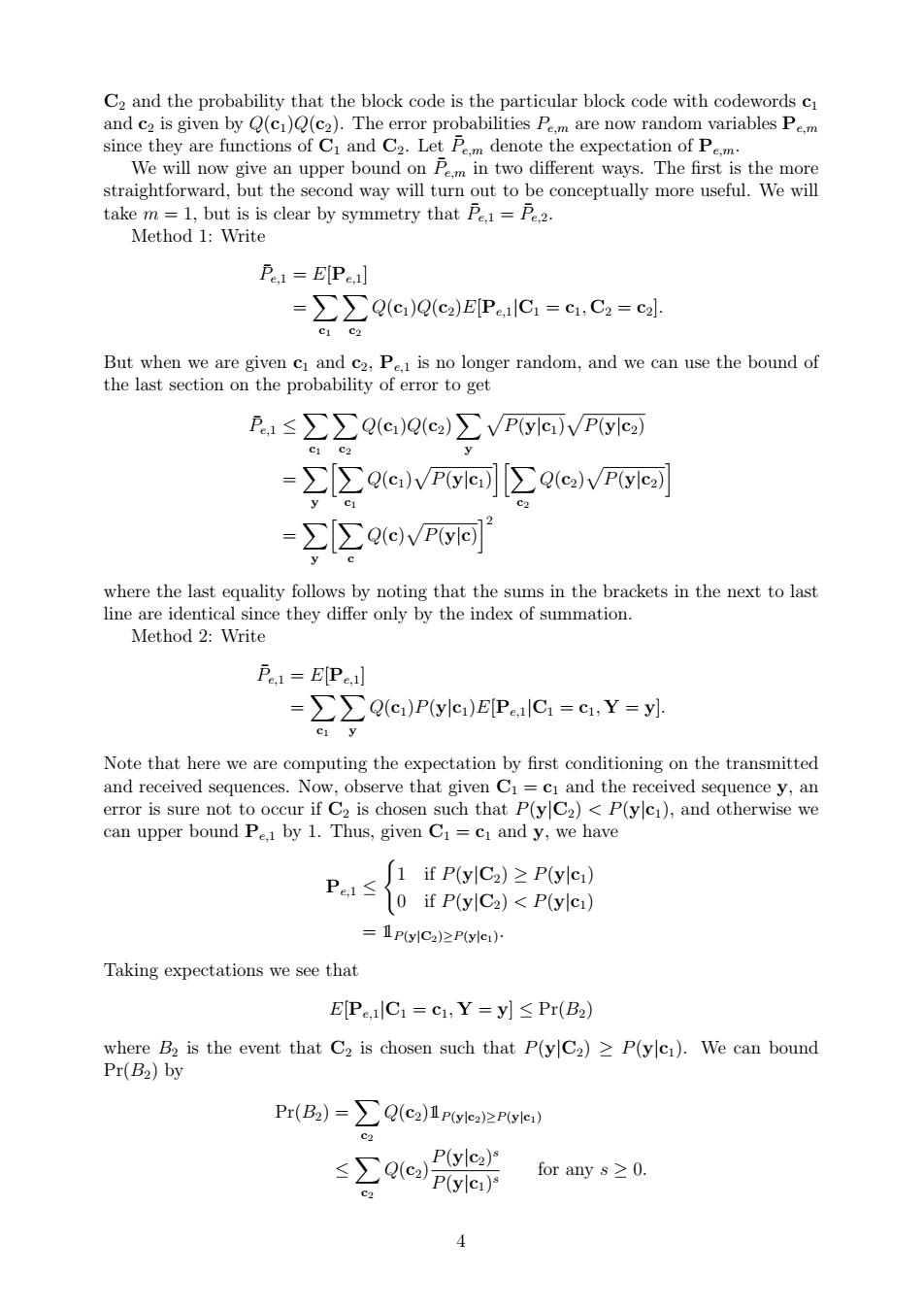正在加载图片...

C2 and the probability that the block code is the particular block code with codewords c and ca is given by (e)(ca).The error probabilities P are now random variables Pm since they are functions of C and C2.Let Pm denote the expectation of P.m We will now give an upper bound on Pm in two different ways.The first is the more straightforward,but the second way will turn out to be conceptually more useful.We will take m=1,but isis clear by symmetry that P=P.2. Method 1:Write P1=E[Pea] =∑∑Q(c)Q(e)E[PlC=c,C=c But when we are given c and c P is no longer random,and we can use the bound of the last section on the probability of error to get ps∑∑QcQe)∑VP(ylc.)VP(ylca) =P可Q可 =∑∑Q(e)vP(yk可 Method 2:Write Pe1 E[Pel] =>Q(ci)P(ylci)E[PealCi =c1,Y =y]. Note that here we are computing the expectation by first conditioning on the transmitted and received sequences.Now,observe that given Ci=ci and the received sequence y,an error is sure not to occur if C2 is chosen such that P(yC2)<P(ylc1),and otherwise we can upper bound Pe by 1.Thus,given C1=c1 and y,we have ∫1 if P(y]C2.)≥Pylc) Pa1≤0 P(ylCa))<Ple) =IP(yICa)zP(ylei) Taking expectations we see that E[Pe.lC1=C1,Y=y]<Pr(B2) the nt at C.that P)P) Pr(B2)=>Q(c2)1P(ylea)zP(yle) for any s≥0. ¥C2 and the probability that the block code is the particular block code with codewords c1 and c2 is given by Q(c1)Q(c2). The error probabilities Pe,m are now random variables Pe,m since they are functions of C1 and C2. Let P¯ e,m denote the expectation of Pe,m. We will now give an upper bound on P¯ e,m in two different ways. The first is the more straightforward, but the second way will turn out to be conceptually more useful. We will take m = 1, but is is clear by symmetry that P¯ e,1 = P¯ e,2. Method 1: Write P¯ e,1 = E[Pe,1] = X c1 X c2 Q(c1)Q(c2)E[Pe,1|C1 = c1, C2 = c2]. But when we are given c1 and c2, Pe,1 is no longer random, and we can use the bound of the last section on the probability of error to get P¯ e,1 ≤ X c1 X c2 Q(c1)Q(c2) X y p P(y|c1) p P(y|c2) = X y hX c1 Q(c1) p P(y|c1) ihX c2 Q(c2) p P(y|c2) i = X y hX c Q(c) p P(y|c) i2 where the last equality follows by noting that the sums in the brackets in the next to last line are identical since they differ only by the index of summation. Method 2: Write P¯ e,1 = E[Pe,1] = X c1 X y Q(c1)P(y|c1)E[Pe,1|C1 = c1, Y = y]. Note that here we are computing the expectation by first conditioning on the transmitted and received sequences. Now, observe that given C1 = c1 and the received sequence y, an error is sure not to occur if C2 is chosen such that P(y|C2) < P(y|c1), and otherwise we can upper bound Pe,1 by 1. Thus, given C1 = c1 and y, we have Pe,1 ≤ ( 1 if P(y|C2) ≥ P(y|c1) 0 if P(y|C2) < P(y|c1) = 11P(y|C2)≥P(y|c1) . Taking expectations we see that E[Pe,1|C1 = c1, Y = y] ≤ Pr(B2) where B2 is the event that C2 is chosen such that P(y|C2) ≥ P(y|c1). We can bound Pr(B2) by Pr(B2) = X c2 Q(c2)11P(y|c2)≥P(y|c1) ≤ X c2 Q(c2) P(y|c2) s P(y|c1) s for any s ≥ 0. 4